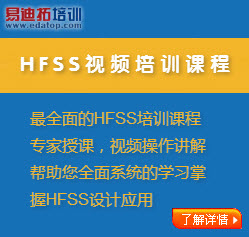个人认为不是,功率为电压与电流相位和,而二者相位一般不相等。
P=V*(I的共轭),相位是加哈,不是平方
站长的回答值得敬佩,给人恍然大悟的感觉!
对于一个阵列的各个端口而言,I的相位和v的关系往往是固定得,比如对电容,两者差90度,这个关系对各个端口应该是相同得,这样v*(I的共轭)后,相位貌似也是固定的,和v无关,也就是各个端口的功率的相位应该是一样得,可电压的相位是不同得,是不是矛盾了?感觉想不通
四楼的问题我同样感觉很疑惑
站长大人,刚才我仿真了一下,发现对于微带线来说,不管微带线多长,电压和电流差180度,这样各个端口的功率相位总是一样得,那hfss的edit source里的port,模的单位是瓦,也就是按功率设置得吧?后面的相位该怎么设置啊?
我计算得到得是电压的大小和相位,所以在edit source里就犯难了啊
Note that in the modal case a unit stimulation means 1 Watt of incident power at the port; in the terminal case a unit stimulation means 1 volt of total voltage at the terminal. After converting the voltage stimulation to the equivalent power stimulation the antenna results agree perfectly. In particular, the "ratioed" antenna parameters such as gain, directivity, and efficiency agree between the modal and terminal projects, while absolute antenna quantities such as incident power, accepted power may initially appear different. This is a direct result of the difference in edit-sources stimulations in the two types of projects.
2. Select the source whose magnitude and phase you want to scale.
If your solution type is driven terminal, a voltage source magnitude and phase may be set for the selected terminal.
3. In the Scaling Factor text box, enter the factor by which the value of the source is to be scaled. Design variables can be used as source scalings.
Note
You may not enter a negative voltage. To obtain the equivalent of a negative magnitude, add or subtract 180 degrees from the phase value.
If you use a design variable as a scaling factor note that solutions are invalidated if the variable is changed.
If the model contains symmetry planes, the Edit Sources dialog alerts you that you may need to adjust the scaling factor accordingly.
At least one source should be excited (non-zero). If you set all sources to zero, you will receive a warning, but the values do go through.
4. In the Offset Phase text box, enter the new phase for the source.
The phase of the source is changed by the value that you enter.
我的理解,也就是说HFSS里那个相位设置就是按照电压来的。HFSS里这个相位差应该指的是两个激励端口之间,电压有多少相位差。我想功率应该跟相位没有关系的,比如在一条均匀传输线上,只有行波,没有反射波,那这条传输线上各个位置处的功率大小应该是一样的。
你所指的所谓的功率相位相同,但电压的相位是不同的,你觉得矛盾,是因为你没考虑到电压跟电流之间有相位差啊。你看麦克斯韦方程,电生磁,磁生电,正是因为这个相位差,才使得两者互相激励
声明:网友回复良莠不齐,仅供参考。如需更专业、系统的学习HFSS,可以购买本站资深专家讲授的HFSS视频培训课程。


